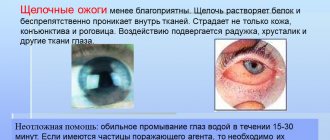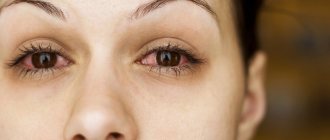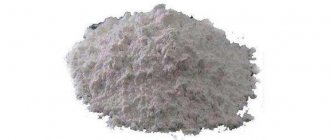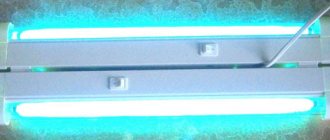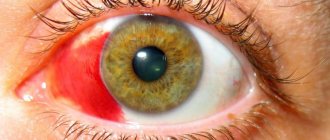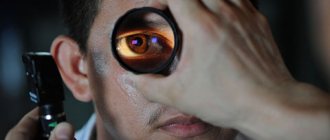Eyes are the most vulnerable place of our body. They consist of a large number of parts, each of which performs an important function. It is enough to damage one of them for a person to partially or completely lose the ability to see. For minor injuries, the process is temporary, and visual acuity returns after adequate treatment. However, if the damage is severe, changes in the eye may be irreversible.
The most common injury to this organ is a burn received while operating a gas welding machine. The electric arc releases such a large amount of energy that it is divided into two parts. The first generates a thermal (thermal) wave that directly melts the metal. The second one creates strong ultraviolet radiation. Eye burns from welding can result from both of these effects.
Structure of the eye
To understand why you should not delay providing first aid for eye burns, and why they are dangerous, you need to know the approximate structure of the organ. Its structures are arranged sequentially. They can be roughly divided into those that refract light and those that perceive images. The latter includes only the retina.
Let's list the main parts, starting with the most superficial:
- The conjunctiva is a thin protein membrane covering the eye;
- The cornea is the first structure to refract light;
- The iris is an important part consisting of muscle, connective tissue and pigment cells that give a certain color to the eye. Regulates the process of pupil dilation/constriction;
- The lens is a biconvex lens-shaped structure of the eye that focuses light;
- The sclera is the largest layer of the eye and performs protective and refractive functions;
- The retina senses light and gives rise to the optic nerve.
If one of these structures is damaged, the eye cannot perform its function normally. A burn to the retina has the most severe consequences, since this part consists entirely of nerve endings and is responsible for the perception of light.
Symptoms
An eye burn, even the slightest, does not go away without a trace, in which case the following symptoms are observed:
- Intense pain syndrome;
- Photophobia;
- Blepharospasm;
- Swelling of the conjunctiva and cornea;
- lacrimation;
- Redness of the skin of the eyelids;
- Red or white spots on the eyeball;
- Inflammation of the vessels of the membrane;
- Increased intraocular pressure;
- Cloudiness of the cornea;
- Changing the field of view.
It is worth knowing that many symptoms do not appear immediately; the intensity of their formation may increase within 8 hours after the injury. To eliminate them, timely pre-hospital emergency care is needed for eye burns.
How can you burn your eyes when welding?
Depending on the cause of occurrence, there are two types of eye burns from welding:
- Thermal - it develops when very hot substances or liquids come into contact with one of the parts of the eye. The organ of vision can be damaged by flying scales, splashes of hot metals, scalding steam (when using hot-dip galvanizing technology, hot air welding, etc.);
- Ultraviolet burn (radiation) - this injury can be caused not only by a welder, but also by an ordinary passer-by who looks at the electric arc. Ultraviolet light typically only damages the surface of the eye, so it is considered less dangerous.
First aid and treatment differ significantly for various eye injuries, so it is important to promptly determine the type of burn. This can be done using simple signs that will be described below.
Diagnostic measures
After emergency care for a chemical burn of the eye, it is necessary to conduct a diagnosis. This is done to determine the degree of damage to the eye and the nature of progressive complications.
Diagnostic measures include:
- assessment of visual acuity;
- Ultrasound of the organ of vision and orbits;
- biomicroscopic scanning of the eyeball;
- ophthalmoscopy;
- electrophysiological studies;
- tonometry.
Immediately after the results are obtained, a treatment regimen for a chemical burn of the eye is drawn up.
Chemical burn to the eyes
This type of damage is much more dangerous than exposure to scale or exposure to ultraviolet radiation. Eye burns from chemicals manifest themselves with the same symptoms as after welding. However, there is one important difference - in 85% of cases the damage is deep and irreversible.
In principle, chemical burns are divided into acid and alkaline.
Alkali burn
Typical representatives of alkalis are soda, lime, ammonia solutions, and cleaning products. They are present in every person’s everyday life, and are extremely dangerous if they come into contact with the eyes. The fact is that alkalis enter into chemical reactions with the conjunctiva, cornea and sclera, rapidly destroying them. Therefore, a chemical burn to the mucous membrane of the eye quickly becomes deep and damages all structures, right up to the retina.
It is quite difficult to remove alkali from fabrics, so it is important that first aid is provided as early as possible.
Acid burn
Easier to deal with than alkali damage. When acid gets in, the superficial structures of the eye are often damaged. During the chemical reaction, a lot of protein is released from the destroyed mucosa, which delays the acid on its way to the retina. Therefore, with timely assistance, visual function can be preserved.
In everyday life, the following acids are most often used:
- Potassium permanganate (synonym: potassium permanganate) - there is an additional sign that will help determine damage to manganese. At the same time, the mucous membrane turns brownish-brown;
- Vinegar;
- Nitric acid – is included in almost all solutions for cleaning metals;
- Formaldehyde is a typical component of nail polish remover;
- Lemon acid;
- Boric acid.
Features of burns with acids and alkalis
Eye burns from sulfuric acid are not as dangerous as from alkali. This is due to the fact that a film of coagulated protein forms on the eye when the irritant reacts with the mucous membrane. The film does not allow acid to penetrate deep into the eye, protecting the eye from deep damage. However, coagulation does not protect against complications if a concentrate of nitric and hydrofluoric acids gets into the eyes. An acid burn is characterized by severe pain, and sometimes even painful shock.
It is noteworthy that when the eye is damaged by alcohol, a person experiences severe pain, but minimal damage is noted. However, alcohol can absorb moisture from the lubricating fluid and the eyeball, penetrating deep into and damaging the cornea and lens. If washed in a timely manner, there will be no consequences for vision.
The most dangerous are alkali burns. In this case, there is severe dehydration and cell destruction. Alkalies provoke the decomposition of protein structures, wet necrosis develops, and when the irritant gets into the intraocular fluid, the deep structures of the eye are affected. Alkali can reach the corneal stroma and trabecular meshwork. As a result, the cornea becomes cloudy and intraocular pressure increases.
Common symptoms of a chemical burn
- Deterioration of vision. The initial decrease in visual acuity is caused by epithelial defects, increased lacrimation, clouding and discomfort. Even with moderate to severe burns, vision may be preserved if the corneal clouding is minor, but severe deterioration will occur over time.
- Fragments of the irritant in the arches of the outer shell. Residues of foreign matter are visible when plaster and other solid irritants enter the eye. The fragments must be removed immediately, otherwise they will continue to release toxins and worsen the damage. Only after cleansing the eye does the natural recovery process begin. Carbide and lime are the most dangerous because they dissolve in the tear and cause severe damage. If these substances come into contact, do not delay cleansing.
- Increased intraocular pressure. A sharp increase in pressure occurs due to deformation and contraction of collagen fibers in the anterior part of the eyeball. Subsequently, the increase is associated with inflammation.
- Inflammatory process in the conjunctiva. Even with mild damage, swelling and redness of the mucous membrane is noted. Sometimes when a burn occurs, the color of the conjunctiva changes (brown when damaged by chromic acid, yellowish when exposed to nitric acid).
- Perilimbal ischemia. Based on the degree of blanching, one can make a prediction about the restoration of the cornea, because limbal sprout cells restore the epithelium. Severe ischemia indicates an unfavorable course of the process.
- Cloudiness. If the cornea is transparent, a zero degree of damage is determined, and if the cornea is completely clouded, the fifth degree is determined. Complete stromal opacification makes it impossible to examine the anterior chamber of the eye.
- Defects of the corneal epithelium. Damage to the cornea can be expressed as diffuse punctate keratitis or complete absence of the epithelium. In the latter case, the defect is poorly stained with fluorescein and may not be diagnosed. If the epithelial defect is not visible during the initial examination, prompt re-examination is recommended.
- Corneal perforation. The symptom appears a few days after a severe eye burn, when the cornea's ability to regenerate decreases.
- Inflammation in the anterior region. The reaction may affect single cells or have a pronounced fibrinoid form. Inflammation is more pronounced when alkali gets into the eye, since these substances can penetrate deep into the structures.
- Scarring or other damage to the conjunctiva and eyelids. The symptom may be a problem if scarring prevents the palpebral fissure from closing.
Symptoms of an eye burn
Regardless of the cause of the burn (ultraviolet radiation, scale, acid, etc.), eye damage manifests itself with almost the same symptoms. These include:
- Severe lacrimation;
- Pain in the eyes;
- Decreased visual acuity;
- Increased sensitivity to light (or even photophobia);
- Redness of the eyes due to the appearance of a vascular pattern on the sclera;
- Feeling of “sand in the eyes” - the patient constantly wants to rub his eyes or wash them with cold water. This symptom is very pronounced when the cornea of the eye is burned by welding;
- Blepharospasm is uncontrolled squinting of the affected eye.
If hot objects (scale, steam, etc.) come into contact, the eyelids may additionally burn, which is manifested by their redness, swelling and the formation of blisters. Severe or prolonged exposure to high temperatures can even lead to necrosis (death) of the eyelids. This greatly complicates the treatment of the burn.
Symptoms of a retinal burn
A severe burn from ultraviolet radiation or a chemical can cause damage to the deep structures of the eye - the retina. This is one of the most severe injuries, which manifests itself as irreversible loss of vision or blindness. During the acute period of the disease (4-6 hours after contact with ultraviolet radiation), the following may additionally be observed:
- Redness of the conjunctiva;
- Pain in the eyes;
- Blepharospasm;
- Photophobia.
After a few days, most symptoms disappear, but myopia/blindness remains forever.
Conservative treatment helps slow down the damage process, but eye function can only be restored through surgical methods (retinal transplantation).
How to determine the type of burn
The symptoms of eye burns for different types are very similar, and they should be provided first aid and treated differently. What to do in such a situation? There are special signs that make it quite easy to determine the real cause of the burn. To do this, you need to carefully question and examine the patient to detect differences.
| Distinctive feature | Thermal burn | Ultraviolet burn |
| Time of onset of symptoms | Immediately after contact with a hot substance in the eye area | No less than 4 hours later |
| What parts of the eyes are affected? | Most often, one of the following structures is affected:
| As a rule, ultraviolet radiation from welding damages all parts of the eye (except the retina) at the same time. With severe exposure, the burn can even affect the retina. |
| Symptom severity | Depends on the amount of hot substance that gets into the eye and the duration of its exposure. The following degrees of damage are distinguished:
| Most often, ultraviolet burns slightly affect the structures of the eye, so the symptoms are mild. An exception is a retinal burn. With this pathology, all symptoms appear in full force. |
| Duration of symptoms | From a few days to the end of the patient's life | Symptoms decrease after a few hours (exception: retinal burn) |
Diagnosis of eye burns during welding is carried out on the basis of patient complaints and the above symptoms. Laboratory and instrumental methods, as a rule, are not of fundamental importance.
First aid for eye burns caused by welding
What to do in case of a thermal burn?
If the burn is caused by hot substances getting into the eye (scale, steam, etc.), the following steps should be taken:
- Remove visible parts of the foreign substance (a piece of metal, plastic or any other cause of burn);
- Rinse the affected eye generously with distilled (purified) water. For this purpose, it is convenient to use a large 20-50 ml syringe. The patient should open the eyelid slightly and irrigate the conjunctiva generously for 5-15 minutes;
- If possible, the patient should be given one of the following drugs: Diphenhydramine, Nimesulide, Ketorol, Ibuprofen, Analgin. As a rule, they can be found in any medicine cabinet or women's handbag. These medications will somewhat reduce pain and inflammation;
- Apply an aseptic bandage or cold compress to the affected eye;
- Call an ambulance (ambulance) team.
The paramedic/doctor at the ambulance will provide qualified assistance to the victim and decide whether the patient should be hospitalized or whether he can be treated on an outpatient basis.
What to do if you are burned by ultraviolet light?
Treatment of eye burns during welding should begin with first aid. After exposure to ultraviolet light you must:
- Remove the source of ultraviolet light (electric arc, quartz lamp, etc.), if this has not been done previously;
- Reduce the load on the affected eye as much as possible - place the victim in a dark room, exclude exposure to bright light, recommend that the patient keep his eyes closed for 30-60 minutes;
- Apply an aseptic dressing;
- Anesthetize the patient using any available means: apply cold for 5-10 minutes, take NSAIDs (Ketorol, Analgin, Paracetamol, Citramon, etc.), instill anesthetic drops (Lidocaine, Tetracaine);
- If you have Diphenhydramine, you should give the patient 2 tablets. This drug somewhat inhibits damage to eye tissue and improves the prognosis;
- Contact an ophthalmologist or call an ambulance team.
An indicator of correct treatment is a significant reduction in symptoms within a few hours. If this does not happen, then therapy should be reconsidered and the eye checked for retinal damage.
First aid for chemical burns
- Rinse eyes with distilled (purified) water for 30 minutes. It is recommended to use a large syringe for this. Continue until clean rinse water is obtained;
- Call an ambulance - the faster the ambulance team arrives, the higher the chances of a favorable outcome of the burn;
- It is necessary to apply a special disinfectant ointment behind the eyelids; as a rule, 1% Levomycetin is used;
- Apply an aseptic bandage to the eye.
First aid for a chemical burn to the eyes should be provided within 3-5 minutes for optimal effect.
First aid
First aid should be provided immediately after the accident occurs. Immediately after the incident, it is necessary to carry out the following PMP algorithm for chemical eye burns:
- Rinse your eyes well with saline solution or plain clean water. It is recommended to do rinsing not under running water, but to fill a container with warm water, lower your face into it and blink vigorously. This action should be performed for at least 20 minutes.
- In case of a chemical burn with acid, it is recommended to use a soda solution or potassium permanganate for washing.
- The effect of an alkaline agent can be neutralized with a 2% acetic acid solution.
- If there are foreign particles in the eye, they must be carefully removed.
- To eliminate pain, you should take a painkiller.
After this, you need to apply a sterile bandage to the sore eye and send the victim to the doctor. In order for the ophthalmologist to select the most effective treatment, it is recommended to take with you a bottle of the damaging substance.
What not to do if you have an eye burn
- Wipe the eye with dry objects (clothing, towels, napkins, etc.) or with your own hand;
- Apply hot lotions/objects to the eyes;
- Continue working with the source of the burn (gas welding machine, ultraviolet lamps, hot steam, etc.);
- Rinse your eyes with dirty water (river, tap water, etc.) - it contains a large number of microbes and harmful impurities, which can cause an infection or increase eye damage;
- Do not instill Sulfacetamide, Albucid, Sulfacyl sodium and other drops containing irritants and antiseptics. Special treatment should be carried out only after consultation with a doctor.
Treatment of eye burns
After providing first aid, you should consult a doctor, who will determine what to do next if your eyes are burned by welding or chemicals. For superficial damage, as a rule, it is enough to use eye drops and “visual rest” - avoiding bright light, eye strain when looking into the distance, etc. This will help reduce discomfort and slightly reduce pain.
The composition of eye drops for eye burns from welding must contain several components - an antibiotic and an anti-inflammatory agent (glucocorticosteroid hormone). It is this combination of drugs that is found in the drugs Maxitrol, Sofradex and Combinil Duo. If it is not possible to purchase them, you can use two drugs at the same time:
Antibiotic for eyes
- Ciprofloxacin;
- Tsipromed;
- Tobramycin.
Anti-inflammatory (in the form of eye drops)
- Dexamethasone;
- Dexamethasonelong;
- Dexapos.
For severe pain, it is possible to use anesthetics in the form of drops: Leocaine 0.3%; Dicaine 0.3%, Alcaine. However, you should not take them more often than in the prescribed regimen. Otherwise, they can irritate the affected eye and delay its healing.
Deep damage (retinal burn) can only be cured by surgery. Diphenhydramine or Chloropyramine eye drops are used to reduce inflammation, but these drugs will not help restore vision.
Drops recommended for different types of burns
For any type of burn, it is important to relieve pain and prevent infection from entering the affected tissue.
For thermal burns
For thermal damage, the following drops can be used:
- Inocaine. The active substance is benoxynate hydrochloride. Local anesthetic that blocks nerve endings.
- Visoptician. Eliminate photophobia, itching, burning, lacrimation, swelling.
- Okomistin. An antiseptic that forms a protective film on injured tissues.
- Prokulin. Relieves swelling, pain, has a vasoconstrictor effect.
As part of complex therapy for burn damage to the eyes, Emoxipin is prescribed, which helps restore energy metabolism in tissues and accelerates their healing, strengthens blood vessels, restores blood circulation, and stimulates regeneration processes.
In case of deep damage, anti-inflammatory eye drops Diclofenac are used, which regenerate the mucous membrane and have preventive properties.
For radiation burns
Radiation burns are treated with the following drops:
- Corticosteroids. Hydrocortisone, Dexamethasone, which help eliminate local swelling.
- Lidocaine. The solution contains sodium chloride and benzalkonium, lidocaine hydrochloride. Prescribed for eye burns to reduce tissue sensitivity.
- Derinat. Drops with an immunomodulatory effect. They help quickly regenerate injured areas, preventing the appearance of scars.
- Phloxal. Drops with antibacterial action. Prevents infection of damaged tissues.
- Tsiprolet. Antimicrobial drops for a wide range of applications. In case of eye burns, they are instilled 5 times a day, 2 drops into each eye.
- Levomycetin (active ingredient chloramphenicol) acts against most gram-positive and gram-negative bacteria.
Drops for chemical burns
A 1% solution of Dicaine helps with eye burns of chemical origin.
This is a local anesthetic that contains sodium chloride and leocaine, which reduces the sensitivity of sodium channels through which pain impulses are transmitted. Drops reduce pain and have a local anesthetic effect. Atropine is used. The active ingredient of the drops is atropine sulfate. Helps relieve pain and prevent adhesions.
Ciprofloxacin also helps, which has anti-inflammatory and antibacterial effects.
Consequences of eye burns
With timely treatment of superficial burns, they do not have any consequences in the future. The eye recovers within a few weeks, and acute reactions (pain, redness, feeling of “sand”) subside within a few days. To speed up regeneration, you can use Etaden or Etadec-MEZ drops, which stimulate metabolism in the tissues of the cornea and conjunctiva
After damage to the retina, as a rule, the patient's vision begins to decline irreversibly. The consequences of such an eye burn are blindness, decreased quality of life and loss of professional suitability (for some specializations). All these phenomena can be eliminated with the help of an operation that is performed in regional ophthalmological centers - retinal transplantation. Modern technologies make it possible to restore a person’s vision within a few weeks of hospitalization.
Unfortunately, such medical care is practically not funded by the state, so the patient has to be treated at his own expense.
Surgical treatment of eye burns and possible complications
If conservative methods are ineffective, surgical treatment of the consequences of the burn is performed. Depending on the complications, a variety of techniques are used.
Surgical treatment for an eye burn may include:
- partial removal of areas of necrosis of the conjunctiva or corneal surface;
- temporary covering with amniotic membrane;
- transplantation of limbal cells or cultured corneal epithelial cells;
- removal of the fusion of the conjunctiva of the eyelids with the eyeball (symblepharon).
To speed up rehabilitation, penetrating or partial keratoplasty and keratoprosthesis are used. If a cataract occurs, it is extracted.
Primary complications of a chemical burn include conjunctivitis, corneal erosion, swelling or clouding, acute increase in intraocular pressure, and melting of the cornea. Secondary complications are usually more varied.
Possible consequences of a chemical burn to the eye:
- glaucoma;
- cataract;
- scarring of the conjunctiva;
- corneal ulcers;
- thinning and tearing of the cornea;
- destruction of the corneal surface;
- opacification and vascularization;
- subatrophy of the eye.
The main measure to prevent burns is to follow safety precautions when working with household chemicals and in production where chemicals are used. It is important to exercise caution and wear safety glasses.




